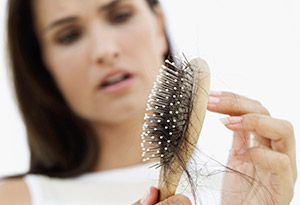9 Things to Know if You're Losing Your Hair

Photo: Thinkstock
Our obsession with our hair reaches a whole new level when we start losing it. What we could once bend (or straighten or color) to our will feels suddenly, terrifyingly beyond our control. Or is it? Many of the causes of hair loss—crash dieting, reactions to medications—are temporary; address the underlying issue and your hair will grow back. Unfortunately, the most common culprit, genetic female pattern hair loss, is chronic. But you don't have to operate at a loss.
You're Not Alone
60% of women are dealing with some degree of hair loss...or have in the past...or will in the future.
The Good Bets
The topical solution
Minoxidil (brand name Rogaine), the only FDA-approved medication for female hair loss, is available over-the-counter in 2 and 5 percent formulas. (Only the lower dose is approved for women.) Massage it into your scalp twice a day; you should notice regrowth in six months. Results last only as long as you use the medicine. ($50 for a three-month supply)
The prescription drug
Spironolactone (brand name Aldactone) and finasteride (brand names Propecia and Proscar) are antiandrogen medications that can be prescribed off-label to postmenopausal women. (The drugs can cause birth defects, so they're not given to women of childbearing age.) Some 50 percent of women with female pattern hair loss will likely see regrowth. (Up to $90 for a one-month supply)
The permanent route
With a hair transplant, hair is removed from one part of the scalp and then implanted where you're thinning. Tiny "follicular units" of two to four hairs are transplanted; this can be effective even for women with diffuse thinning and few areas of "donor hair." In a survey of hair transplant surgeons led by dermatologist Walter Unger, MD, over half said that at least 40 percent of women with female pattern hair loss are candidates for surgery; many of those doctors believe that up to 80 percent of women with thinning hair can see successful results. ($3,000 to $15,000, depending on number of grafts and transplant sessions)
Instant and Cheap Gratification
Fullmore ($22) is a tinted spray that temporarily thickens hair with tiny fibers and conceals visible scalp. Hair restoration specialist Lucinda Ellery tells clients to try it before committing to extensions; for many it's the only fix they need.
Pantene AgeDefy Advanced Thickening Treatment ($20) is a styling spray that plumps each hair fiber. In a study published in the British Journal of Dermatology in 2011, it increased the diameter of individual hairs significantly, by about 10 percent.
The Future Looks Bright (and Very Full)
Not satisfied with existing hair loss solutions? Sit tight...Some doctors are already using platelet-rich plasma (PRP) to stimulate hair growth, and there are many studies under way on the best methods to harness the technology. When separated from a patient's own blood, platelets release growth factors, which are then injected into the scalp to stimulate the hair shafts. "So far we're seeing decreased hair loss after one or two treatments, and some degree of new growth after three to five," says New York City dermatologist Neil Sadick, MD.
Bimatoprost, the synthetic prostaglandin in the prescription lash-growth serum Latisse, is in clinical trials for FDA approval as a topical scalp hair loss treatment. It could be available in the next few years.
Many researchers are investigating hair cloning. "I am hopeful that by 2025, we will be able to multiply hair from a small biopsy to produce unlimited follicles for transplantation," says hair restoration surgeon Alan Bauman, MD.
More on Thinning Hair



